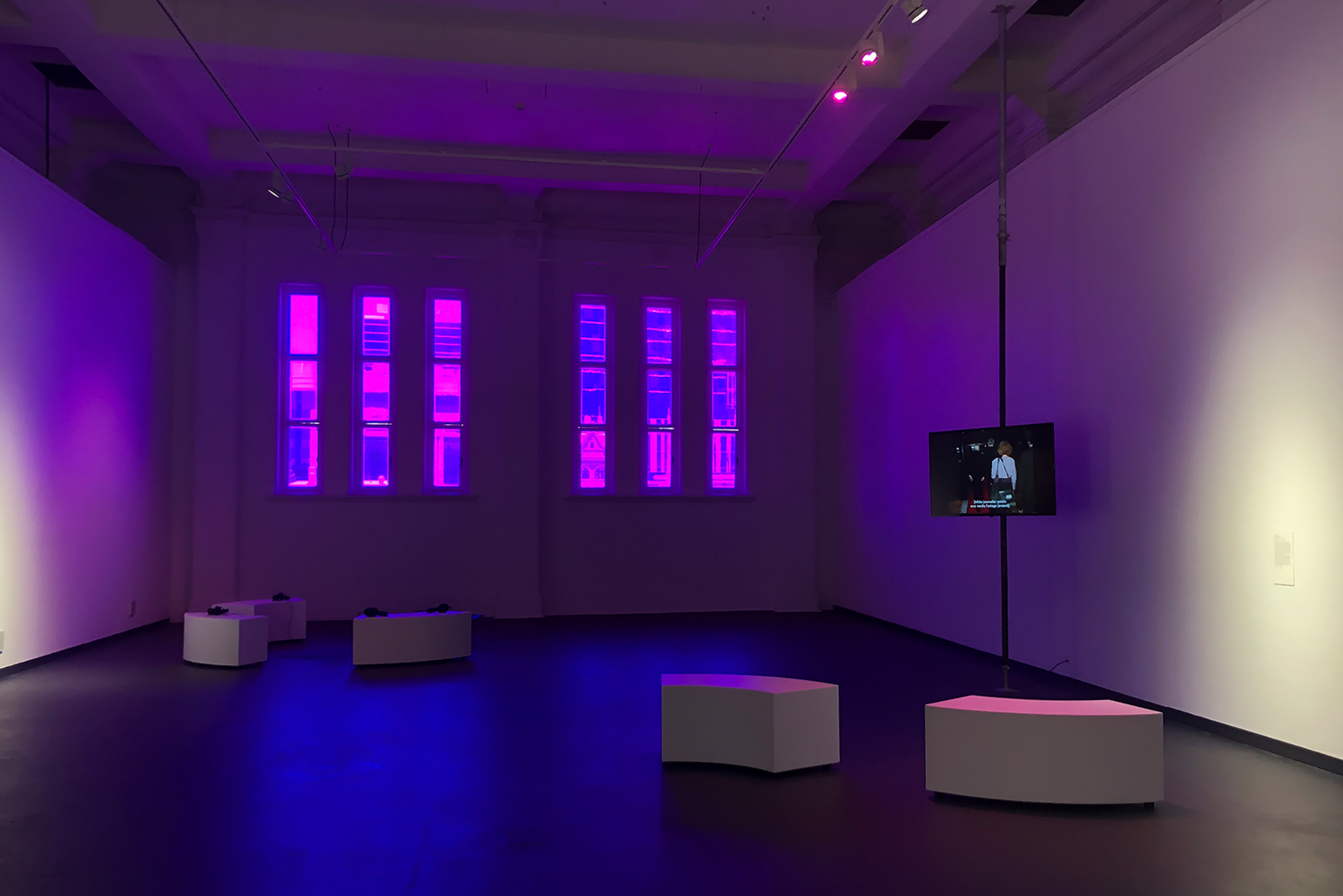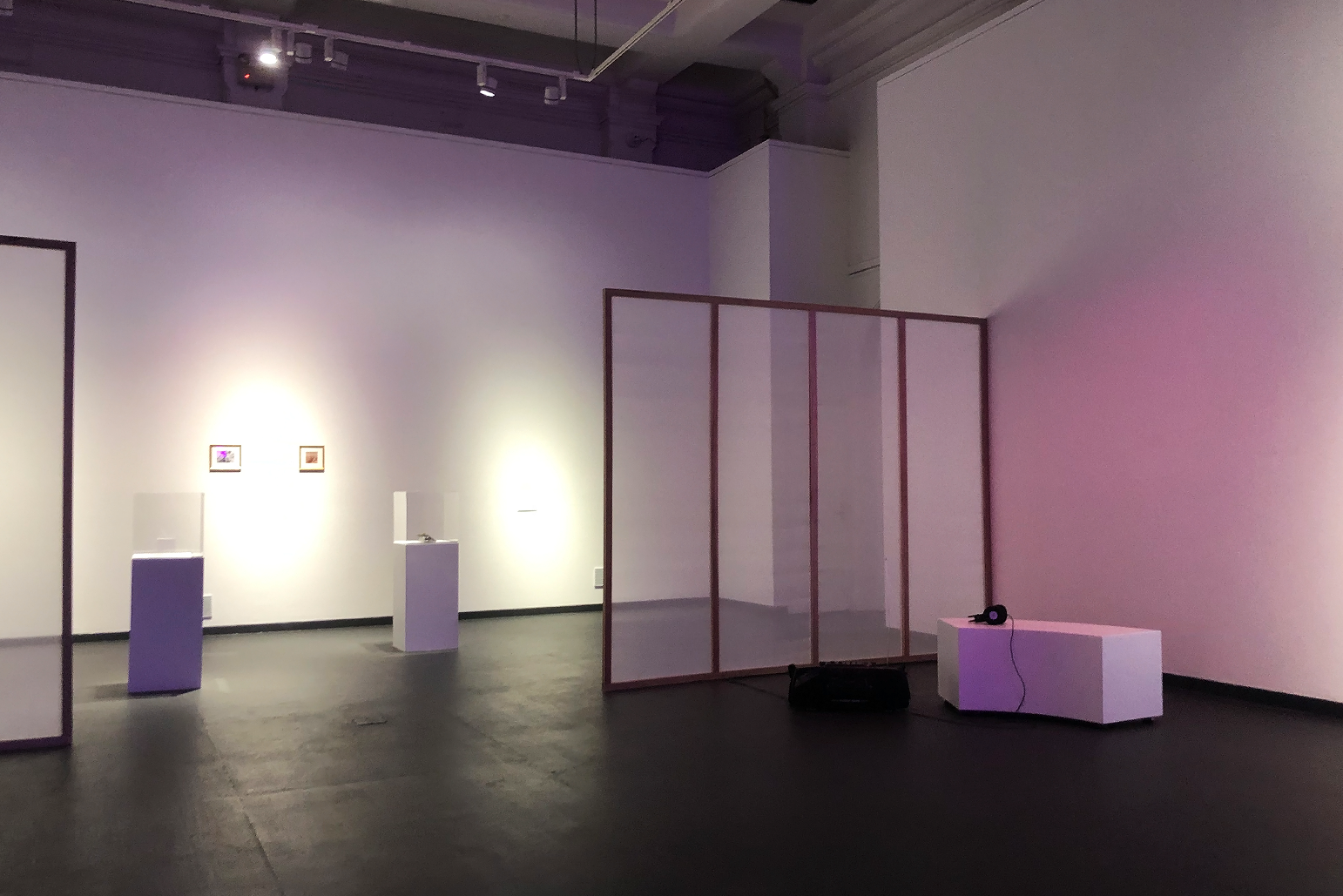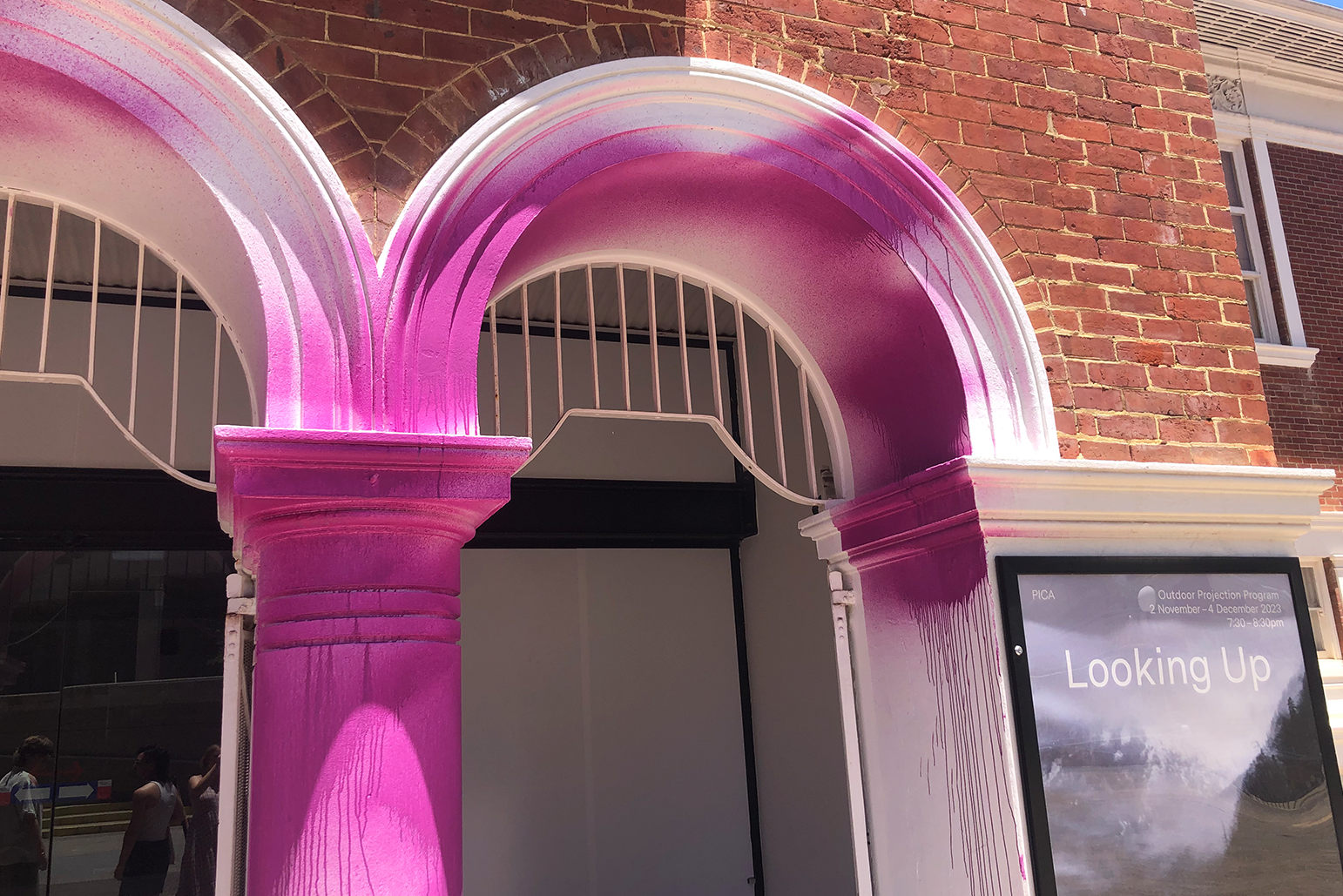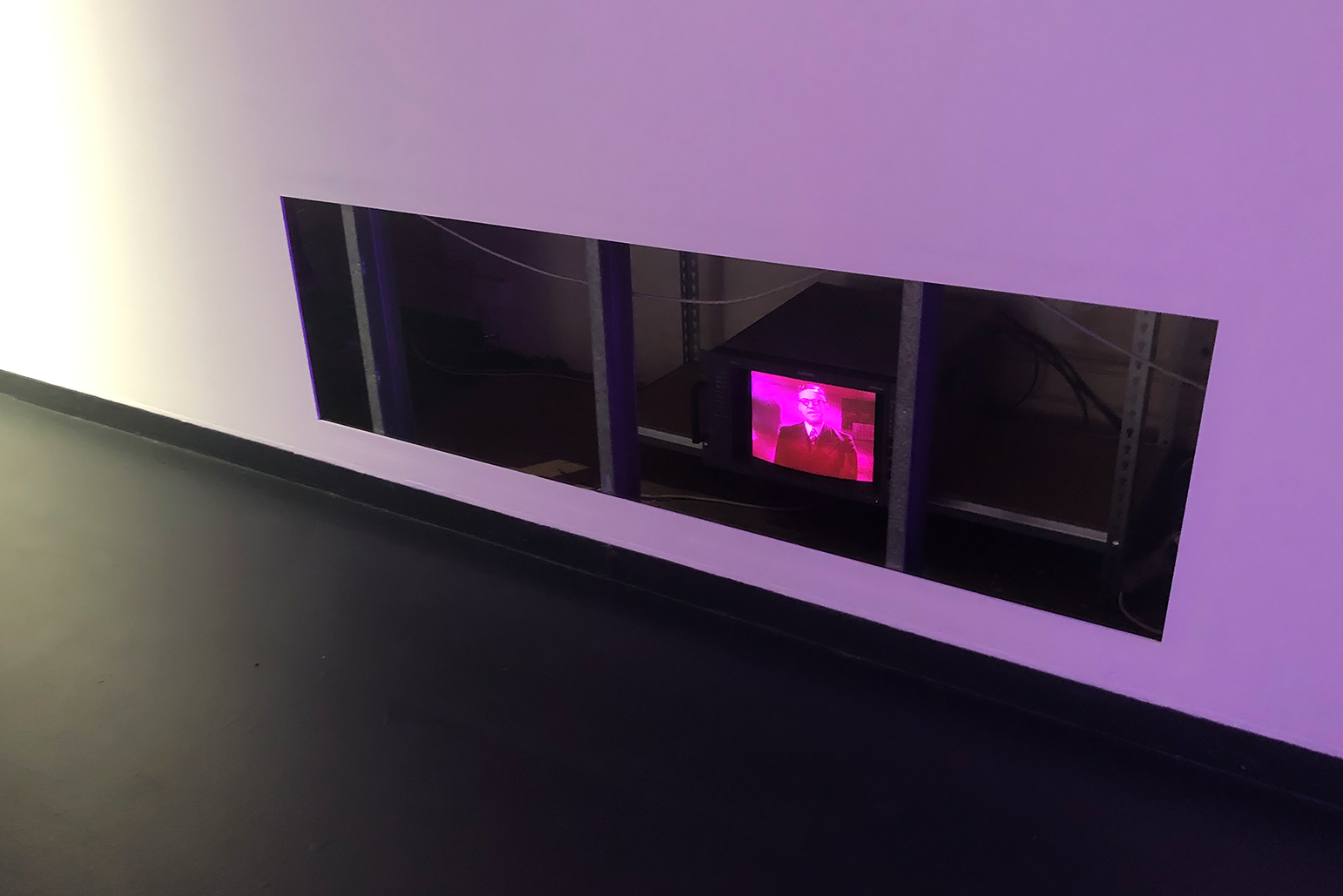



The Purple Shall Govern (at PICA 3 November – 31 December 2023) was a revitalising and multifaceted exhibition that elicited viewer involvement, creating a sense of accountability that permeated beyond the perimeters of the white cube or the exhibition run time. Inviting and uncomfortable in turns, Roberta Joy Rich’s exhibition offered an opportunity to recognise and question skewed social complexities that linger beyond the lifespans of buried politicians, parties, and policies.
A couple of months and opposing reviews out from the close of Rich’s PICA solo show and there’s nary a dust mite to be found. The stir caused by this exhibition demonstrates how fiercely it tugged at hearts, consciences, and nerves. Yet the emerging conversations, accusations, and reflections have all overlooked what is perhaps the greatest strength of the show, a quality that distinguishes this exhibition from less successful attempts to scrutinise and navigate lingering settler-colonial dynamics: viewer involvement. To engage with The Purple Shall Govern is to take up an active role in meaning-making. Rich wove together archival interventions and complex spatial considerations to construct participatory conditions, reminding viewers of their ongoing contribution to the dynamics of social access in contemporary (“post”-colonial) Australia.
Founded upon a perceived misallocation of focus, Max Vickery’s scathing review likened Rich’s radical museum practice to the act of memorialisation. In Vickery’s account, the show contained ‘interesting slippages’ but ultimately immortalised a single event (the momentary turning of a purple water cannon onto authorities during Cape Town’s 1989 Purple Rain protest) at the expense of attention that ought to have been placed on the experiences and struggles of the working class. Without entering the territory of a literary analysis (which Timmah Ball’s un Projects article nearly functions to do—minus any mention of the elephant itself, it is worth reflecting that The Purple Shall Govern is discussed by Vickery as a means to sharpen a congratulatory self-image. In Vickery’s discussion of memorialisation, a moment is selected to be cast in stone as to demonstrate values of the present. It is true that attempts at bronze-casting and compartmentalisation strip any sense of involvement or continued responsibility—a clean knife stroke between past and present—but Rich’s exhibition avoids such short-sightedness through the construction of a self-determined viewing experience.
Rather than a stagnant celebration of misallocated significance, I found The Purple Shall Govern to be a thought-provoking exhibition characterised by a layering of simultaneous, sometimes competing, narratives and experiences. Memorialisation functioned here as an evocative tool, as a ‘means to’ remember, acknowledge, and question. The exhibition’s title, a reference to the graffiti which blossomed throughout Cape Town following the 1989 Purple Rain Protest and to the Freedom Charter of the 1950s, celebrates multiple varied moments of resistance in order to examine current freedoms of movement in public space.[1] Stained by casually splashed violet, PICA’s violated (formerly snowy) bank-pillar archways were a first indication of the tactful disruption and reconfiguration to come upstairs. The Purple Shall Govern was split between a large gallery room (straight ahead) and a small reflection room (to the immediate right). The latter contained varied texts on and by leaders in the struggle against apartheid and unjust social and politically enforced structures in Australia, alongside meditative materials in a cosy, relaxed space equipped with beanbags and a welcoming dining room style seating arrangement: a contemplative enclave.
Viewers entering The Purple Shall Govern’s main exhibition space encountered an implied doorway between frosted screens, an unexpected slowing point in this shared passage of entry and exit. A structural imposition of transparency and opacity, this preceding gallery-within-a-gallery housed several personal archival materials within museum display cabinets, and several wall-mounted family photographs (with Aunty Thelma’s Identity Card placed in relationship to Cousins Gathering in Cape Town, South Africa). This spatial denial of access subtly acquaints the viewer with one of the most hated aspects of apartheid legislation—the restriction of movement.
The purple-sunlight-flooded space beyond, finally reached, was complicated and layered with works and interventions which call out equally and simultaneously. Viewers wove unique webs as they navigated the space, gently pulled from one observation to the next as works were either sought out or discovered. Aided by the careful placement of wall labels (often grouped and distanced from the work), the absence of an exhibition floor sheet, and several unconventional formats for display, Rich staggers access to the exhibition content, problematising and disrupting a consistent, and perhaps an expected, viewing experience. Travelling through The Purple Shall Govern left me with a feeling that I had witnessed something private or forbidden, a sensation that I suspected was mirrored by others as we cautiously (guiltily?) sidestepped each other moving to the ‘next’ work in our own uncoordinated floor plans. The exhibition’s spatial resistance to a linear reading manifested the considerations of access and refusal in the revisited archival content displayed, but also placed the burden of decision making upon viewers. Viewers were made responsible for seeking and allocating importance, becoming accomplices in scrutinising or shattering, and then reconfiguring, fragments of collective memory.
Timmah Ball provides a particularly interesting contribution to the reading of The Purple Shall Govern in her defensive un Projects review, Archival / Activism by approaching Rich’s curatorial choices as viewer-led curation. In a comparison to Samira Farah, Guled Abdulwasi and Patrick Jonathon’s, 2021 collaboration 13 Years, Ball quotes a radio interview in which Farah explains their interest in making “…spaces feel as if they belong to people rather than making it feel like it belongs to the curator.”[2] Ball offers that “Rich embodies these values in her own practice, which, like Farah [sic], uses archival material connected to South Africa’s apartheid era and enduring community activism.”[3] Unfortunately the article does not go further to indulge this insight, underestimating The Purple Shall Govern’s participatory conditions (perhaps, in part, because of its preoccupation with rebuttal—a rebuttal that is laced with almost as much indignation as Vickery’s original smouldering critique. However, even considering Rich’s layering of ideas and perspectives (varying in scale, positioning, and scope), one may argue that the requirement to make decisions and to physically interact (i.e., to travel through, seek, discover, sit in circle formations, use audio equipment) is not enough to prevent viewer passivity. Rich answers this concern by cleverly placing the self as an anchoring point throughout The Purple Shall Govern.
Consider the shifted proximity that Rich builds between viewer and work (a manipulation of access and involvement) in works such as Pigs might Fly and Lunch with the Family at Mignon Street, Cape Town. By censoring the practically unitary accounts of news readers and National and Labor Party politicians from archival footage in Pigs might fly too (2022) and Though Buried, They Echo (2022), Rich constructs alternative retrospective realities centred around an imagined redistribution of access. Rich complicates the viewing of each work by replicating its denial of free movement and policing of “public” space in Apartheid South Africa both conceptually and spatially,. Pigs might fly too sits at an obscure angle, uncomfortably above eye level, while Though Buried, They Echo is semi-concealed behind a Perspex window inlaid into the galley wall at floor level. The constructed separation between viewer and artwork falls away completely in works such as Lunch with the family at Mignon Street, Cape Town (2022), an intimate experience of listening to the artist’s family recount personal histories, anecdotes, and memories. Casually interspersed with family banter, the scraping of cutlery, and the sighs of a well-received meal, it is no stretch for viewers (each immersed with their own headphone set and taking a seat on the circular arrangement) to imagine themselves sharing in this Sunday ritual. These tightly controlled and subtly constructed relationships (distance) between viewer and work are almost entirely neglected by Vickery and Ball’s night-and-day reviews. These relationships are not only controlled, but continually shifted and distorted from one work to the next so that viewers are made constantly aware of their own presence and, because of The Purple Shall Govern’s participatory nature, their own involvement.
Rich’s participatory conditions and varied, ever shifting viewer-content relationships drew attention to historic discrepancies in social access to public space, reminding (or educating) viewers that such distributions cannot yet be consigned to an overcome colonial past, but continue to haunt individual’s movements and freedoms. Caught between embrace and exclusion as viewers decided, prioritised, and wove together narratives from the interweaving of resiliences, experiences, and rememberings, they were confronted with recurring reminders of their own relative position. The Purple Shall Govern forced a consideration of one’s position as a maker of meaning in the exhibition context, but also beyond the gallery walls, as a participant in determining contemporary conditions of social access. An optimistic yet pressing reminder of accountability and shared responsibility. It was a gift for such informative and innovative political art to grace a Boorloo gallery.
Footnotes:
1. Dr Zayd Minty. The Purple Shall Govern: Solidarity in Resistance, ACCA, 2021-2022.
2. Timmah Ball, Archival / Activism, un Projects, 2024.
3. Timmah Ball, Archival / Activism, un Projects, 2024.
Images of Roberta Joy Rich’s The Purple Shall Govern (at PICA 3 November – 31 December 2023) by the author.
A couple of months and opposing reviews out from the close of Rich’s PICA solo show and there’s nary a dust mite to be found. The stir caused by this exhibition demonstrates how fiercely it tugged at hearts, consciences, and nerves. Yet the emerging conversations, accusations, and reflections have all overlooked what is perhaps the greatest strength of the show, a quality that distinguishes this exhibition from less successful attempts to scrutinise and navigate lingering settler-colonial dynamics: viewer involvement. To engage with The Purple Shall Govern is to take up an active role in meaning-making. Rich wove together archival interventions and complex spatial considerations to construct participatory conditions, reminding viewers of their ongoing contribution to the dynamics of social access in contemporary (“post”-colonial) Australia.
Founded upon a perceived misallocation of focus, Max Vickery’s scathing review likened Rich’s radical museum practice to the act of memorialisation. In Vickery’s account, the show contained ‘interesting slippages’ but ultimately immortalised a single event (the momentary turning of a purple water cannon onto authorities during Cape Town’s 1989 Purple Rain protest) at the expense of attention that ought to have been placed on the experiences and struggles of the working class. Without entering the territory of a literary analysis (which Timmah Ball’s un Projects article nearly functions to do—minus any mention of the elephant itself, it is worth reflecting that The Purple Shall Govern is discussed by Vickery as a means to sharpen a congratulatory self-image. In Vickery’s discussion of memorialisation, a moment is selected to be cast in stone as to demonstrate values of the present. It is true that attempts at bronze-casting and compartmentalisation strip any sense of involvement or continued responsibility—a clean knife stroke between past and present—but Rich’s exhibition avoids such short-sightedness through the construction of a self-determined viewing experience.
Rather than a stagnant celebration of misallocated significance, I found The Purple Shall Govern to be a thought-provoking exhibition characterised by a layering of simultaneous, sometimes competing, narratives and experiences. Memorialisation functioned here as an evocative tool, as a ‘means to’ remember, acknowledge, and question. The exhibition’s title, a reference to the graffiti which blossomed throughout Cape Town following the 1989 Purple Rain Protest and to the Freedom Charter of the 1950s, celebrates multiple varied moments of resistance in order to examine current freedoms of movement in public space.[1] Stained by casually splashed violet, PICA’s violated (formerly snowy) bank-pillar archways were a first indication of the tactful disruption and reconfiguration to come upstairs. The Purple Shall Govern was split between a large gallery room (straight ahead) and a small reflection room (to the immediate right). The latter contained varied texts on and by leaders in the struggle against apartheid and unjust social and politically enforced structures in Australia, alongside meditative materials in a cosy, relaxed space equipped with beanbags and a welcoming dining room style seating arrangement: a contemplative enclave.
Viewers entering The Purple Shall Govern’s main exhibition space encountered an implied doorway between frosted screens, an unexpected slowing point in this shared passage of entry and exit. A structural imposition of transparency and opacity, this preceding gallery-within-a-gallery housed several personal archival materials within museum display cabinets, and several wall-mounted family photographs (with Aunty Thelma’s Identity Card placed in relationship to Cousins Gathering in Cape Town, South Africa). This spatial denial of access subtly acquaints the viewer with one of the most hated aspects of apartheid legislation—the restriction of movement.
The purple-sunlight-flooded space beyond, finally reached, was complicated and layered with works and interventions which call out equally and simultaneously. Viewers wove unique webs as they navigated the space, gently pulled from one observation to the next as works were either sought out or discovered. Aided by the careful placement of wall labels (often grouped and distanced from the work), the absence of an exhibition floor sheet, and several unconventional formats for display, Rich staggers access to the exhibition content, problematising and disrupting a consistent, and perhaps an expected, viewing experience. Travelling through The Purple Shall Govern left me with a feeling that I had witnessed something private or forbidden, a sensation that I suspected was mirrored by others as we cautiously (guiltily?) sidestepped each other moving to the ‘next’ work in our own uncoordinated floor plans. The exhibition’s spatial resistance to a linear reading manifested the considerations of access and refusal in the revisited archival content displayed, but also placed the burden of decision making upon viewers. Viewers were made responsible for seeking and allocating importance, becoming accomplices in scrutinising or shattering, and then reconfiguring, fragments of collective memory.
Timmah Ball provides a particularly interesting contribution to the reading of The Purple Shall Govern in her defensive un Projects review, Archival / Activism by approaching Rich’s curatorial choices as viewer-led curation. In a comparison to Samira Farah, Guled Abdulwasi and Patrick Jonathon’s, 2021 collaboration 13 Years, Ball quotes a radio interview in which Farah explains their interest in making “…spaces feel as if they belong to people rather than making it feel like it belongs to the curator.”[2] Ball offers that “Rich embodies these values in her own practice, which, like Farah [sic], uses archival material connected to South Africa’s apartheid era and enduring community activism.”[3] Unfortunately the article does not go further to indulge this insight, underestimating The Purple Shall Govern’s participatory conditions (perhaps, in part, because of its preoccupation with rebuttal—a rebuttal that is laced with almost as much indignation as Vickery’s original smouldering critique. However, even considering Rich’s layering of ideas and perspectives (varying in scale, positioning, and scope), one may argue that the requirement to make decisions and to physically interact (i.e., to travel through, seek, discover, sit in circle formations, use audio equipment) is not enough to prevent viewer passivity. Rich answers this concern by cleverly placing the self as an anchoring point throughout The Purple Shall Govern.
Consider the shifted proximity that Rich builds between viewer and work (a manipulation of access and involvement) in works such as Pigs might Fly and Lunch with the Family at Mignon Street, Cape Town. By censoring the practically unitary accounts of news readers and National and Labor Party politicians from archival footage in Pigs might fly too (2022) and Though Buried, They Echo (2022), Rich constructs alternative retrospective realities centred around an imagined redistribution of access. Rich complicates the viewing of each work by replicating its denial of free movement and policing of “public” space in Apartheid South Africa both conceptually and spatially,. Pigs might fly too sits at an obscure angle, uncomfortably above eye level, while Though Buried, They Echo is semi-concealed behind a Perspex window inlaid into the galley wall at floor level. The constructed separation between viewer and artwork falls away completely in works such as Lunch with the family at Mignon Street, Cape Town (2022), an intimate experience of listening to the artist’s family recount personal histories, anecdotes, and memories. Casually interspersed with family banter, the scraping of cutlery, and the sighs of a well-received meal, it is no stretch for viewers (each immersed with their own headphone set and taking a seat on the circular arrangement) to imagine themselves sharing in this Sunday ritual. These tightly controlled and subtly constructed relationships (distance) between viewer and work are almost entirely neglected by Vickery and Ball’s night-and-day reviews. These relationships are not only controlled, but continually shifted and distorted from one work to the next so that viewers are made constantly aware of their own presence and, because of The Purple Shall Govern’s participatory nature, their own involvement.
Rich’s participatory conditions and varied, ever shifting viewer-content relationships drew attention to historic discrepancies in social access to public space, reminding (or educating) viewers that such distributions cannot yet be consigned to an overcome colonial past, but continue to haunt individual’s movements and freedoms. Caught between embrace and exclusion as viewers decided, prioritised, and wove together narratives from the interweaving of resiliences, experiences, and rememberings, they were confronted with recurring reminders of their own relative position. The Purple Shall Govern forced a consideration of one’s position as a maker of meaning in the exhibition context, but also beyond the gallery walls, as a participant in determining contemporary conditions of social access. An optimistic yet pressing reminder of accountability and shared responsibility. It was a gift for such informative and innovative political art to grace a Boorloo gallery.
Footnotes:
1. Dr Zayd Minty. The Purple Shall Govern: Solidarity in Resistance, ACCA, 2021-2022.
2. Timmah Ball, Archival / Activism, un Projects, 2024.
3. Timmah Ball, Archival / Activism, un Projects, 2024.
Images of Roberta Joy Rich’s The Purple Shall Govern (at PICA 3 November – 31 December 2023) by the author.
